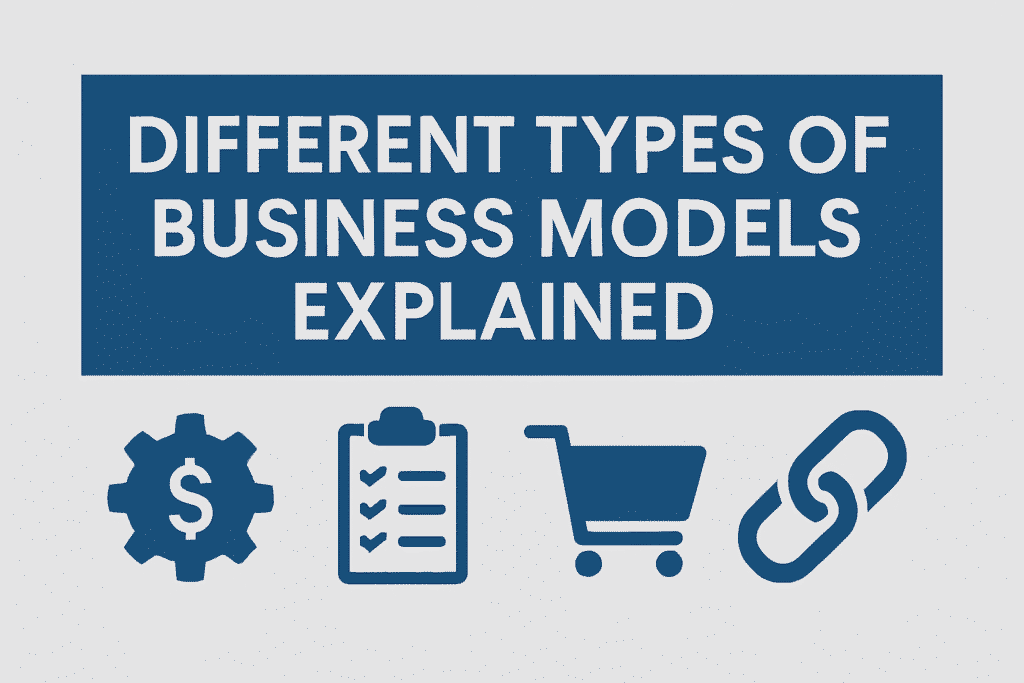
Table of Contents
In the dynamic arena of commerce, a company’s business model isn’t just a buzzword; it’s the fundamental blueprint for survival and growth. It dictates how an organization creates, delivers, and captures value. Choosing the right model is akin to selecting the engine for a vehicle – it determines performance, efficiency, and the journey’s viability. For entrepreneurs launching a startup, business students deciphering corporate strategies, or seasoned professionals seeking innovation, understanding the diverse landscape of business models is paramount. This article delves into the core concept, explores five prominent types with real-world examples, compares their strengths and weaknesses, and underscores why this knowledge is critical for navigating today’s competitive environment.
What Exactly is a Business Model?
At its essence, a business model is the strategic plan outlining how a company operates profitably. It answers fundamental questions:
- Who is our target customer?
- What value proposition do we offer them?
- How do we deliver that value (channels, key activities)?
- How do we generate revenue and sustain profitability (revenue streams, cost structure)?
Think of it as the narrative explaining how all the pieces of a business puzzle fit together – from product development and marketing to sales, operations, and finance. A well-defined business model clarifies the path to monetization and competitive advantage. Pioneering work by Alexander Osterwalder and Yves Pigneur in the Business Model Canvas provides a widely adopted framework for visualizing and designing these core components.
Exploring Five Key Types of Business Models
Numerous business models have evolved to meet diverse market needs. Here, we dissect five prevalent and impactful types:
1. The Subscription Model
How it Works
Customers pay a recurring fee (monthly, quarterly, annually) for ongoing access to a product or service. Revenue is predictable and based on customer retention.
Advantages
- Predictable Revenue: Creates stable cash flow, easing financial planning and investment.
- Enhanced Customer Loyalty: Fosters long-term relationships and reduces churn through continuous value delivery.
- Valuable Customer Data: Provides deep insights into usage patterns and preferences for product improvement.
- Scalability: Easier to scale customer base without constant re-selling.
Disadvantages
- Churn Risk: Requires constant value delivery to prevent cancellations; high churn rates can cripple the model.
- Acquisition Costs: Can be expensive to acquire subscribers initially.
- Value Perception: Must continuously justify the recurring cost to customers.
Examples:
Netflix (streaming entertainment), Spotify (music streaming), Adobe Creative Cloud (software suite), Dollar Shave Club (razor blades), The New York Times (digital news).
2. The Freemium Model
How it Works
Offers a basic version of a product or service for free, while charging for premium features, enhanced functionality, increased capacity, or an ad-free experience. The free tier acts as a lead generator and user acquisition tool.
Advantages
- Low Barrier to Entry: Attracts a large user base quickly by removing initial cost friction.
- Effective Marketing: Free users can become brand advocates and drive organic growth.
- Upsell Opportunities: Provides a natural funnel to convert engaged free users into paying customers.
- Network Effects: Can be powerful in platforms where value increases with more users (even free ones).
Disadvantages
- Conversion Challenges: Only a small percentage of free users typically convert to paying customers.
- Supporting Free Users: Costs associated with hosting and supporting a large non-paying user base can be significant.
- Value Balancing: Must offer enough value in the free tier to attract users but reserve compelling features for premium to incentivize upgrades.
Examples:
Spotify (free ad-supported tier vs. Premium), LinkedIn (basic networking free vs. Premium career insights), Dropbox (limited free storage vs. paid plans), Canva (free design tools vs. Pro features), Slack (free limited message history vs. paid plans).
3. The E-commerce Model
How it Works
It involves buying and selling goods or services primarily over the internet. Transactions occur online, and products are shipped directly to customers (B2C) or other businesses (B2B). This encompasses various sub-models like online marketplaces, direct-to-consumer (DTC) brands, and dropshipping.
Advantages
- Global Reach: Access to a vast, worldwide customer base 24/7.
- Lower Overhead: Often reduces costs associated with physical retail spaces (rent, utilities, in-store staff).
- Convenience: Offers unparalleled convenience for customers (shopping from anywhere, anytime).
- Data & Personalization: Enables sophisticated data collection for personalized marketing and recommendations.
Disadvantages
- Intense Competition: Highly saturated market with low barriers to entry in many segments.
- Logistics Complexity: Managing inventory, warehousing, shipping, and returns can be complex and costly.
- Customer Acquisition Costs: Rising digital advertising costs can erode margins.
- Lack of Tangibility: Customers cannot physically interact with products before purchase (can lead to higher return rates).
Examples:
Amazon (massive online marketplace), ASOS (online fashion retailer), Warby Parker (DTC eyewear), Alibaba (B2B/B2C marketplace), Etsy (handmade/vintage marketplace).
4. The Franchise Model
How it Works
The franchisor (original business owner) grants the franchisee (independent operator) the right to use its established brand name, business systems, trademarks, and operational support in exchange for fees (initial franchise fee, ongoing royalties, marketing fees). The franchisee typically owns and operates their local unit.
Advantages (Franchisor)
- Rapid Expansion: Accelerated growth with lower capital investment compared to company-owned expansion.
- Motivated Operators: Franchisees are invested owners, often leading to better local management.
- Revenue Streams: Generates income from fees and royalties.
Advantages (Franchisee)
- Proven System: Access to a recognized brand and a tested business model, reducing startup risk.
- Training & Support: Ongoing operational, marketing, and training support from the franchisor.
- Purchasing Power: Benefit from the franchisor’s bulk buying power for supplies.
Disadvantages (Franchisor)
- Less Control: Maintaining consistent quality and brand standards across independent owners can be challenging.
- Complex Legalities: Requires robust franchise agreements and legal structures.
- Reputation Risk: Poor performance by one franchisee can damage the entire brand.
Disadvantages (Franchisee)
- High Initial Investment: Significant upfront costs (franchise fee, equipment, build-out).
- Ongoing Fees: Royalties and marketing fees reduce net profits.
- Limited Autonomy: Must adhere strictly to the franchisor’s operating procedures and brand guidelines.
Examples:
McDonald’s (fast food), Subway (sandwiches), Hilton Hotels (hospitality), 7-Eleven (convenience stores), The UPS Store (shipping and business services).
5. The Direct Sales Model
How it Works
Products or services are sold directly to consumers, bypassing traditional retail intermediaries (like wholesalers or brick-and-mortar stores). Sales often occur through personal demonstrations, home parties, one-on-one interactions, or dedicated company sales representatives. Can be single-level (salespeople sell only) or multi-level marketing (MLM – salespeople recruit others and earn commissions on their sales).
Advantages
- Higher Margins: Eliminating middlemen allows for potentially higher profit margins per sale.
- Personalized Experience: Enables tailored product demonstrations and strong customer relationships.
- Brand Control: Maintains direct control over the sales message and customer experience.
- Flexibility: Sales can occur in diverse settings (homes, online, events).
Disadvantages
- Scalability Challenges: Reliant on recruiting and managing a large sales force; growth can be slower than wholesale models.
- High Acquisition Costs: Recruiting, training, and motivating sales representatives can be expensive.
- Reputation Issues (especially MLM): Some MLM structures face criticism or skepticism regarding their compensation plans and earning potential for participants.
- Limited Reach: May struggle to reach customers who prefer anonymous or convenient retail shopping.
Examples:
Avon (cosmetics – traditional direct sales/MLM), Tupperware (food storage – party plan), Cutco (knives – one-on-one demos), Dell (historically pioneered direct sales of computers via phone/internet, bypassing retailers), Many B2B companies (selling complex solutions directly to corporate clients).
If you’re trying to choose between them, here’s Sole Proprietorship vs. LLC vs. Corporation: Which One Is Right for You?
Comparative Analysis: Choosing the Right Fit
Selecting the optimal business model hinges on numerous factors: the nature of the product/service, target market, industry dynamics, competitive landscape, capital resources, and the company’s core competencies. Here’s a comparative overview:
| Feature | Subscription | Freemium | E-commerce | Franchise | Direct Sales |
|---|---|---|---|---|---|
| Primary Revenue Driver | Recurring Fees | Premium Upgrades | Online Sales | Franchise Fees & Royalties | Direct Sales Commissions |
| Startup Cost | Moderate-High | Low-Moderate | Low-High (varies) | Franchisee: Very High | Low-Moderate |
| Scalability | High | Very High | Very High | Franchisor: High | Moderate |
| Predictability | Very High | Moderate | Variable | Franchisor: High | Variable |
| Customer Acquisition | Ongoing Effort | Low Barrier (Free) | Highly Competitive | Local Market Focus | Relationship-Driven |
| Key Challenge | Churn Management | Conversion Rates | Logistics & Competition | Quality Control | Sales Force Mgmt |
| Best Suited For | Ongoing Services/Content | Digital Products/Platforms | Physical/Digital Goods | Standardized Services/Retail | High-Touch/Complex Products |
- Subscription: Ideal for businesses offering ongoing value, like software (SaaS), content, or consumables. Prioritizes customer lifetime value (LTV) and retention. Best when customer needs are continuous.
- Freemium: Highly effective for digital products, apps, and platforms where network effects or low marginal costs exist. Thrives when the free tier provides genuine value and the premium tier offers significant enhancements.
- E-commerce: Essential for physical goods in the digital age, particularly for niche products (DTC) or mass-market aggregation (marketplaces). Requires strong logistics and digital marketing capabilities. Ideal when convenience and selection are key drivers.
- Franchise: Excellent for rapidly scaling standardized physical services or retail concepts (food, hospitality, services). Suits franchisors with a proven system and franchisees seeking a turnkey business with brand support. Effective where local presence and consistency matter.
- Direct Sales: Powerful for complex, high-value, or experiential products requiring explanation or demonstration (B2B solutions, luxury goods, unique consumables). Excels in building deep customer relationships. Suitable when personal trust and product education are critical.
To start building around your chosen model, read How to Write a Winning Business Plan.
Conclusion
Understanding the intricacies of different business models is not merely academic; it’s a fundamental strategic imperative. The model chosen forms the bedrock of a company’s operations, revenue generation, and ultimately, its success or failure. As we’ve explored, models like Subscription, Freemium, E-commerce, Franchise, and Direct Sales each offer distinct pathways and challenges, catering to specific products, markets, and operational realities.
The choice is rarely static. Successful businesses often evolve their models, leveraging hybrid approaches (e.g., an e-commerce brand adding a subscription box) or pivoting entirely in response to market shifts, technological advancements, or changing customer expectations. Entrepreneurs must meticulously evaluate their value proposition, target audience, and resources against the strengths and weaknesses of potential models. Business leaders need to continually assess if their current model remains optimal or requires adaptation.
In a world characterized by disruption and innovation, a deep comprehension of business models empowers decision-makers to design resilient, adaptable, and profitable enterprises. It’s the crucial first step in transforming a vision into a viable and sustainable commercial reality. Whether you’re drafting your first business plan or steering an established corporation, never underestimate the power of choosing – and continually refining – the right business model.
